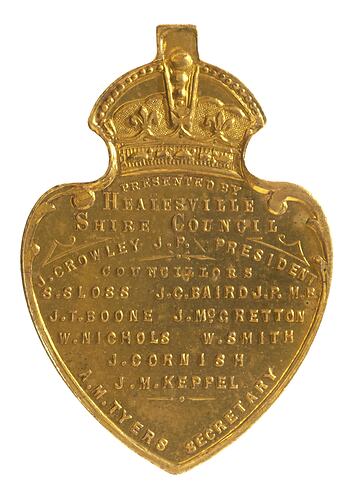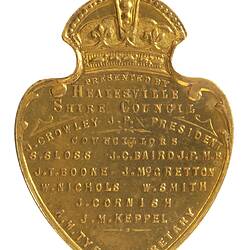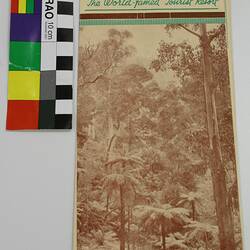Healesville Shire Council was located 52 km east-north-east of Melbourne, just south of the Watts River, a tributary of the Yarra River. Gold was found upstream at nearby New Chum Creek in about 1859, but it was the creation of roads to Gippsland and the Yarra Valley goldfields in the 1860s that resulted in a settlement forming at Healesville. Healesville soon became the place where fresh horses were taken for the ascent to Fernshaw and Blacks Spur.
The site of Healesville was surveyed for a township in 1864. It was named after Richard Heales, Premier of Victoria 1860-61. The first land sale took place the following year, and within twelve months the young town boasted thirty business premises, including six hotels and a primary school. Healesville had been selected as a site for 'neglected black and half-caste children and an asylum for infirm blacks', and the Coranderrk reserve south of Healesville opened in 1865.
Miners from the declining Gippsland goldfields took up farming in Healesville; timber cutters found employment, and hop gardens were established. The Healesville shire was created on 30 September 1887 and the railway opened two years later, stimulating business and population growth. The scenery of Fernshaw was more readily reached from the Healesville train terminus, and tourism became part of Healesville's local economy. Gracedale House, with no fewer than 60 rooms, was built in 1889.
Farming also developed in the newly cleared Don and New Chum Creek Valleys. Orchards and vegetable growing increased their acreages, along with a successful increased tobacco plantation. The Maroondah Weir was built in 1891, requiring the removal of the Fernshaw township and curtailment of timber cutting. In 1893 a library and Mechanics' Institute was opened.
J. Crowley was named as President of the Healesville Shire Council on a medal issued in 1902 to commemorate the coronation of Edward VII (NU 20247). Crowley Road, Healesville, may be named in his honour.
Elaborate country residences were built alongside hotels and guest houses, and a Tourist and Progress Association was created before World War I. The construction of the Maroondah Dam in 1927, replacing the Maroondah Weir, brought several hundred workers to Healesville. Their departure intensified the onset of the Depression. Timber and tourism were not stable enough for sustained growth, and increased motor tourism partly bypassed Healesville. Railway patronage also decreased. A local newspaper suggested that Healesville would be 'heaps better off calling itself the good-time town instead of the world-famed-tourist-resort - that's got whiskers on it'.
In 1934 the Sir Colin Mackenzie Sanctuary for Australian Fauna and Flora was opened on part of the former Coranderrk reserve. Healesville Sanctuary has become one of Victoria's premier tourist attractions.
The outbreak of World War II stimulated timber cutting, which initially concentrated on harvesting trees damaged in the extensive Black Friday bushfire of January 1939. After the war tourism again became the economic focus of the area. Former forestry workers were employed in a range of new small industries making products including knitwear, electrical appliances and soft drinks. In 1957 a new hospital was opened and in 1961 the central school (1952) was replaced by a high school. A new swimming pool was opened in 1964.
In 1958 Yarra Glen district was added to Healesville Shire. Northwards, Buxton went to Alexandra shire on 1 October 1963. The town of Healesville remained the main commercial centre in its shire.
On 15 December 1994 part of Shires of Healesville, Lillydale, Sherbrooke and Upper Yarra united to form the Yarra Ranges Shire Council. Other parts of Healesville were united with the new Nillumbik Shire Council and Murrindindi Shire Council.
References:
Australian Places website, Monash University http://arts.monash.edu/ncas/multimedia/gazetteer/list/healesville.html#heacult, accessed 07/01/2004.
Municipal Association of Victoria website http://www.mav.asn.au, accessed 07/01/2004.
More Information
-
Keywords
-
Localities
-
Authors
-
Article types



